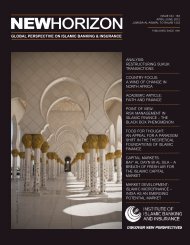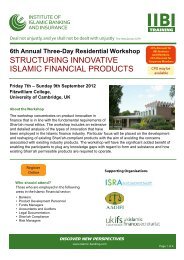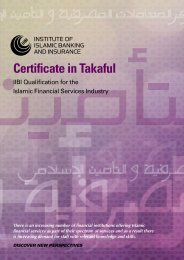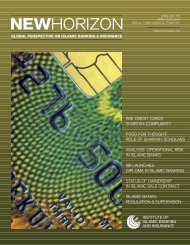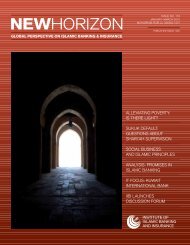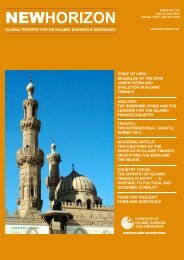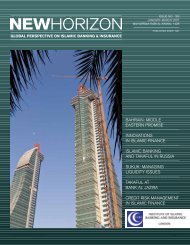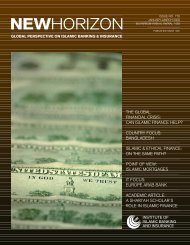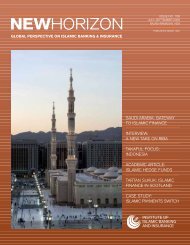azerbaijan: emerging market islamic banking and finance
azerbaijan: emerging market islamic banking and finance
azerbaijan: emerging market islamic banking and finance
Create successful ePaper yourself
Turn your PDF publications into a flip-book with our unique Google optimized e-Paper software.
NEWHORIZON Shawwal–Dhu Al Hijjah 1429<br />
POINT OF VIEW<br />
IBF institutions are expected to operate<br />
within this framework to produce a social<br />
<strong>and</strong> environmentally acceptable optimum.<br />
From utopia to reality<br />
In responding to this moral economy<br />
strategy, the initial experience of IBF in<br />
Egypt in late 1960s was structured as a<br />
socially-oriented institution, aimed to<br />
provide credit to peasants, small<br />
businesses, <strong>and</strong> workers to overcome<br />
financial exclusion <strong>and</strong> exp<strong>and</strong> the<br />
ownership base of society.<br />
However, despite such a novel origin, with<br />
the internationalisation <strong>and</strong> unprecedented<br />
growth in their assets base <strong>and</strong> financing<br />
since 1980s, the lives of Muslim individuals<br />
have not been significantly affected by<br />
such development of IBF, as the social<br />
dimension is limited to zakat <strong>and</strong> other<br />
non-systematic charitable activities, which<br />
negates systematic economic development.<br />
It might be useful, therefore, to compare<br />
the realities against the aspirational<br />
worldview by deconstructing the practices<br />
of IBF through values the practitioners<br />
attach to IBF against the foundational<br />
values mentioned above. Speaking at the<br />
Islamic Finance Seminar held in London<br />
last year, Iqbal Khan, a leading contributor<br />
to the development of the sector, suggested<br />
the following values among the aims of<br />
IBF:<br />
❏<br />
❏<br />
❏<br />
❏<br />
Profit-<strong>and</strong>-loss (PLS) sharing <strong>and</strong> risksharing<br />
is preferred alongside creating<br />
more value addition to the economy;<br />
Community <strong>banking</strong>: serving<br />
communities, not <strong>market</strong>s;<br />
Responsible <strong>finance</strong>, as it builds<br />
systematic checks on financial providers;<br />
<strong>and</strong> restrains consumer indebtedness;<br />
ethical investment, <strong>and</strong> corporate social<br />
responsibility (CSR) initiatives;<br />
Alternative paradigm in terms of<br />
stability from linking financial services<br />
to the productive, real economy; <strong>and</strong><br />
❏<br />
also it provides moral compass for<br />
capitalism;<br />
Fulfils aspirations in the sense it widens<br />
ownership base of society, <strong>and</strong> offers<br />
‘success with authenticity’.<br />
It is clear that these values fit into the<br />
aspirational values of IME as well. A critical<br />
examination of these objectives, however,<br />
indicates that the reality is far from fulfilling<br />
these objectives.<br />
Regarding preference towards equity-based<br />
PLS <strong>and</strong> risk-sharing financing over debt<br />
financing, data analysis, for instance, in<br />
the Malaysian IBF case depicts that the<br />
percentage share of musharakah declined<br />
from 1.4 per cent in 2000 to 0.2 per cent<br />
in 2006, while major modes of Islamic<br />
financing remain to be bai bithaman ajil<br />
(sale of goods on a deferred payment basis;<br />
another term used for such sales is bai<br />
mu’ajjal) <strong>and</strong> ijara wa iqtina (leasing <strong>and</strong><br />
subsequent purchase) with 55.9 per cent<br />
<strong>and</strong> 25.2 per cent respectively in 2006. In<br />
addition, from 1984 to 2006, murabaha<br />
constituted 88.1 per cent of the mode of<br />
financing for Bank Islam Malaysia Berhad,<br />
<strong>and</strong> 67.3 per cent for Dubai Islamic Bank,<br />
while mudarabah <strong>and</strong> musharakah was<br />
about 1.7 per cent <strong>and</strong> 9.3 per cent<br />
respectively.<br />
Moreover, in relation to social lending, the<br />
percentage of qard hasan (an interest-free<br />
loan for welfare purposes/short-term<br />
funding requirements) is at a negligible level<br />
in IBF sector. Taking into account that IME<br />
aims for equity financing for creating value<br />
addition in economic activity, the change<br />
towards debt-financing is rather meaningful,<br />
which indicates that IBF institutions have<br />
deviated from the economic development<br />
<strong>and</strong> social welfare objectives of IME. Thus,<br />
the promise of Islamic <strong>finance</strong> in relation<br />
to its performance failed to be realised in<br />
providing socio-economic development for<br />
the larger parts of the Muslim world <strong>and</strong><br />
communities.<br />
Data analysis also shows that long-term<br />
financing is not the norm, as most of the<br />
financing focuses on projects with<br />
maturities lasting less than a year. In<br />
addition, while developmental financing<br />
necessitates financing sectors such as<br />
agriculture <strong>and</strong> manufacturing, the majority<br />
of IBF is related to retail or trade financing.<br />
For instance, after the initial years, Islamic<br />
banks in the Sudan moved away from<br />
financing agriculture <strong>and</strong> industry using<br />
PLS schemes. Furthermore, instead of<br />
investing in value-added economic activity<br />
in the Muslim countries, there has been a<br />
tendency to invest the funds abroad. As a<br />
result, the value addition of IBF to the local<br />
economy has further declined, <strong>and</strong> the<br />
contribution of IBF for economic<br />
development through real economy has<br />
been rather elusive.<br />
Regarding the community <strong>banking</strong><br />
objective, experience shows that IBF<br />
has done little to contribute to capacity<br />
building in the communities. On the<br />
contrary, IBF has aimed at becoming part<br />
of the international financial <strong>market</strong>s <strong>and</strong>,<br />
despite the social expectations, IBF claims<br />
that it is not a charity, <strong>and</strong> that firms have<br />
to work under difficult competitive<br />
conditions. Clearly, this indicates profit<br />
maximisation as the aim, which negates the<br />
importance of societal responsibility.<br />
As regards to responsible <strong>finance</strong>, there<br />
is no universally accepted regulatory<br />
body that systematically checks Islamic<br />
financial providers. The initiatives by<br />
AAOIFI (Accounting <strong>and</strong> Auditing<br />
Organisation for Islamic Financial<br />
Institutions) in Bahrain <strong>and</strong> IFSB (Islamic<br />
Financial Services Board) in Malaysia<br />
remain weak <strong>and</strong> are not generally<br />
adopted. To evidence this, a recent study<br />
demonstrates that a large number of Saudi<br />
Islamic <strong>finance</strong> practitioners, accountants<br />
<strong>and</strong> auditors, are largely unaware of<br />
AAOIFI st<strong>and</strong>ards.<br />
Pertaining to fulfilling aspirations, IBF<br />
has not positively affected social capacity<br />
building <strong>and</strong> contributed to widening<br />
ownership, which could have been possible<br />
through venture capital or PLS type of<br />
investments. However, as discussed<br />
www.newhorizon-<strong>islamic</strong><strong>banking</strong>.com IIBI 11



